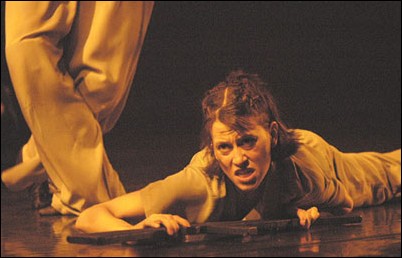Scholl’s fair at love and war

Image: Scholl’s fair at love and war:Haley Bone performs in “What Price Liberty?” in Solano Hall. Photo by David Olson/State Hornet:
November 19, 2003
An American history lesson from a class lecture or a fewchapters in a textbook can’t truly capture the intangibleemotions, heartaches, toils and trials of generations past.
But Sacramento State’s 22-season-old Dale Scholl Dance/Arttroupe, with its five-piece, season premiere performance,”What Price Liberty?,” attempts to &- and succeedsin &- its portrayal of the sentiments surrounding events thatshaped American history.
The pieces, choreographed by various Sac State dance departmentstaff and students and influenced by the songs, poetry, letters andspeeches from different wars, are a fluid mish-mash of ballet, jazzand modern styles. Each piece is peppered with popular moves fromthe wars’ respective generations and danced to the tunes ofeach era.
The small dancespace in Solano Hall 1010, seating a capacity of115, provides an intimate, engaging setting for the audience withsuch a close proximity to the performers.
“What Price Liberty?” opens with an interpretativenumber of Jimmy Hendrix’s electric guitar solo of “TheStar Spangled Banner,” the dancers cleverly mimicking anAmerican flag blowing in the wind with sinuous hand movements.
“Sad and Lonely Weeping,” the Civil War portrayalchoreographed by Nolan T’Sani (New York City Ballet,Sacramento Ballet), captures the colloquial spirit of unadulteratedSouthern culture with heel stompings and a jig.
Slavery’s notorious past is illustrated by KimberlyRowlett’s portrayal of a slave, as she is beaten and thrustdown onto the stage.
The dancers later cluster around the gasping, weary Rowlett inan intense, climactic moment of expectation, as they tear off thecollared chain from her neck and toss it onto the floor.
Joseph Candelaria’s choreography of World WarI’s””Til The Boys Come Home” proves amature effort for the undergraduate dance student, attempting tocapture America’s loss of innocence and the brutality ofmodern warfare.
Numbers like “It’s a Long Way To Tipperary,”with repetitive marching movements and salutations, don’tcommunicate a clear message to the audience in the context of thepiece, despite any enjoyment of the cheery tune.
The dancers mimic the movements of a radar screen and a machinegun to appropriate sound effects, with narrations from theaterprofessor Doniel Soto.
The dancers wrestle in primitive, ape-like behavior to thesounds of a string quartet, depicting a barbarian struggle thatends as all the dancers collapse in a heap. The last dancer,writhing among the other bodies, lets out a silent scream.
WWII’s depiction in “Mission Accomplished”centers around the love story of a young couple soon separated bythe call to arms, their flirtatious courtship illustrated throughclassic songs such as “Amor” and “It Had to BeYou.”
Once the woman (Amy Gilbert) learns that her love, a pilot, ismissing in action, she performs an endearing solo rich with balletmovements to “I’ll Never Walk Alone,” her limbsand her head drooping like a rag doll as she wispfully moves acrossthe stage.
“Waist Deep in The Big Muddy,” the final sequence,shows the Vietnam War’s bloody and drawn-out battles, as thedancers with guns move like a troop in combat. The exasperation ofthe soldiers is shown in songs such as “We’ve Gotta GetOut Of This Place.”
“What Price Liberty?” offers the brutal side of wartold in the artful steps of dance.
————————————————————————————————————–
What: “What Price Liberty?”
When: Nov. 20-22
Times: 8 p.m.
Where: Dancespace, Solano Hall 1010
Tickets: $18 general/$16 students and seniors/$15 CSUSStudents/$9 ages 12 and under.
—————————————————————————————————————















































































































































